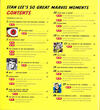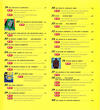Stan Lee's Amazing Marvel Universe
Background
This 2006 book is a curious cross-media combination. The entire package is 12.2" x 11", although the book part is only 10" x 11". The black plastic thing that takes up the rest of the space on the right hand side is a digital audio player with a speaker, battery compartment, play/pause, forward/backwards, and (a brilliant addition) a volume control.
Story 'Contains built-in audio device that plays Stan's reminiscences on co-creating the Marvel Universe'
Stan Lee's Amazing Marvel Universe
| Writer: | Roy Thomas |
| Audio Commentary: | Stan Lee |
"Stan Lee's Amazing Marvel Universe" is a guided tour of the highlights of Stan's career as a writer and co-creator at Marvel Comics. It is written by Roy Thomas, the brilliant young man who was the immediate editorial successor to Stan at Marvel comics. Roy's involvement gives him an insight into Stan's creative processes that could only have been matched by Jack Kirby himself. Roy is also a well-recognised writer in his own right.
The book itself is sturdy hardback with 200 glossy pages, and it features 50 "Marvellous Marvel Moments" in the publishing career of Stan Lee. It begins with Stan's very first creative effort for Marvel, his two page text story in Captain America Comics #3, back in 1941.
Then there's a big jump forward in time to to "Moment 2: Fin Fang Foom in Strange Tales #89," before Moment 3 finally starts bringing out the big guns with Fantastic Four #1. From then on it's just a matter of jumping from milestone to milestone: FF #4 (Sub-Mariner), Hulk #1, FF #5 (Doctor Doom), Amazing Fantasy #15, Journey Into Mystery #83 (Thor), and so on...
The chronology of Stan's career is clearly illustrated by the dates on the comics that are featured here. 40 of the 50 "moments" are from the 1960's. Six are Stan Lee guest-written stories from the 70's, then the last four are scattered through the 80's and 90's. That's not to suggest that Stan Lee's contribution to comics was short-lived. He contributed two decades of tireless service in the 40's and 50's too. For more info on that part of Stan's working life, check out Stan Lee and the Rise and Fall of the American Comic Book.
Each moment gets four pages, naturally featuring key panels from the story and a summary of the plot. More importantly, Roy also gives us an insight into the context and the creative process that lay behind each story. He talks about what Stan wanted to achieve with the story, and identifies any social and commercial factors that affected the publishing decision. Interaction between Stan and publisher Martin Goodman is often referenced, as well as some mention of discussions between Stan and the artists.
There's a fascinating variation in these backgrounds. Sometimes Stan and Marvel wanted to copy successful elements from other titles (both their own and their competitors). Sometimes Stan wanted to do something completely different - either for artistic or personal reasons, or because he thought that a new approach would be a differentiating factor in the marketplace.
General Comments
The creation process of these classic Marvel issues and characters has been enthusiastically investigated in recent decades (as much as surviving documents and ageing human memories allow). I didn't spot any single earth-shattering new fact that I wasn't already aware of. That's just as I anticipated. Roy and Stan have both spoken freely in the past, and really I didn't expect any staggering surprises to come out of the woodwork.
Probably the main "new" thing for me as a Spider-Fan was regarding the Spider-Man co-star appearance in Daredevil #17. While still acknowledging Steve Ditko's contribution on Amazing Spider-Man, Stan makes it clear that he knew that Ditko wouldn't be doing the book for much longer. Stan admits that he wrote Spider-Man into Daredevil basically as an audition for DD artist John Romita, to see if JR was ready to take over the Spider-Man title when the time came. Turns out he was.
But with or without pivotal revelations, there are still two things which make this book very special indeed as a reference book.
Firstly, the Stan Lee audio commentary is superb. It has clearly all been recorded in a single session. Stan's voice shows his octogenarian age, and the writing links into the book seamlessly, so I would be quite confident that the recordings were specifically made for this publication. There are 68 sound clips, each around 20-30 seconds duration. I'm sure Stan has already related these anecdotes and philosophical thinkings a hundred times before. But for those who have never been lucky enough to hear the man speak in person, hearing these snippets in context just adds a whole new dimension.
Secondly, while it may well be possible to dig up most of this information from other sources, interviews, fan magazine stories, and so on... why would you want to go to all that effort? This book has done all that work for you. Sure, if you're looking for insight about Stan as a person, you might be better off with reading Stan Lee and the Rise and Fall of the American Comic Book and The Stan Lee Universe. But if you're looking for the background regarding Stan Lee's role in the creation of these classic stories... well, I think "Stan Lee's Amazing Marvel Universe" is as good as it gets.
Stan's attitude towards his co-creators can be a bit erratic. Sometimes he gives them full credit, sometimes he gets distracted and forgets to acknowledge their contribution. This time around, he does a pretty decent job of recognising the great work done by Ditko and Kirby. There are a few moments where Stan gets caught up in his own achievements... but I guess that's what he's famous for, and he's certainly earned the right to do so now and again.
Note: Despite Spider-Man being the only super-hero to appear on the cover of this book, he appears in only maybe ten or a dozen of the "moments". That's a reasonable balance. Sure, Spidey is important to Marvel, but he's not the be-all and end-all.
Overall Rating 




This book works perfectly. Firstly, it's a superb reference volume for the history behind these classic stories. Secondly, the audio from Stan elevates this book into something really quite special. I hadn't expected the voice segments to add so much, but I was most surprised at what a difference the audio clips made. They're not just a gimmick - they're an integral part of the work.
Five webs. All keen Marvel historians should own this book.






